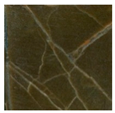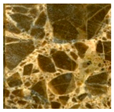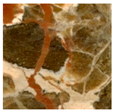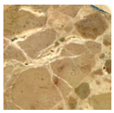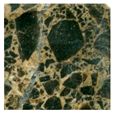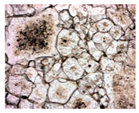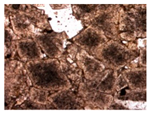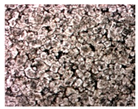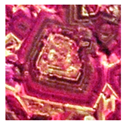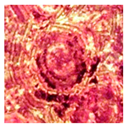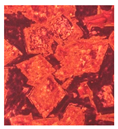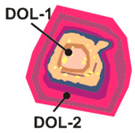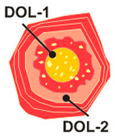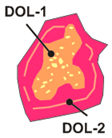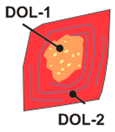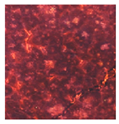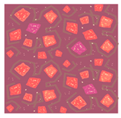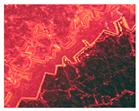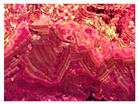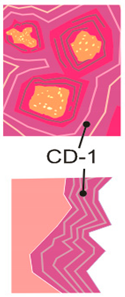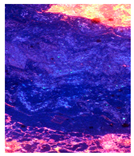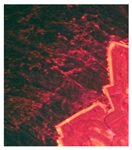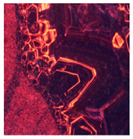Abstract
The “Marrón Emperador” ornamental stone is known for its characteristic deep brown colour filled with white spots and veins. It consists of a brecciated dolostone with different generations of calcite/dolomite veins and veinlets that represent repeated episodes of fracture opening and partial or complete cementation, which likely corresponds to individual stages of fluid expulsion. Mineralogical, petrographic and geochemical studies point to the formation of these rocks through brecciation, dolomitization and rapid cementation processes in an active tectonic regimen. The composition and textural features of the stratiform dolomite geobody point to a structurally controlled dolomitization model. The overall breccia geometry, breccia texture and vein characteristics are all consistent with a brecciation origin driven by hydraulic fracturing, with subsequent calcite precipitation in open space and partial solution replacement of clasts. A paragenetic sequence includes: (1) marine sedimentation of original tidal carbonate sediments; (2) early lithification and marine cementation; (3) burial diagenesis with early fracturation of limestones; (4) entrance of dolomitizing fluids through fractures causing pervasive dolomitization (brown dolostones) and dolomite cements (fracture-lining and saddle dolomites); (5) fracturation by hydraulic overpressure under an active tectonic regime; (6) calcite cementation (white veins and veinlets); and (7) uplift and meteoric diagenesis producing dedolomitization, karstification and local brecciation.
1. Introduction
Brecciated carbonate rocks, including dolostones, are relatively abundant in geological records and commonly host economic deposits, such as exhalative sedimentary (SEDEX) zinc-lead deposits or constitute important hydrocarbon reservoirs [1,2,3,4,5]. In addition, carbonate breccia constitutes a type of ornamental rock widely used for decorative and architectural purposes since historical times, given its particular and attractive visual appearance [6]. Dolomitic breccia usually are the result of a complex diagenetic history that is responsible not only for their nature, but also for their aesthetic quality properties [7].
Several models have been proposed to explain both dolomitizaction and brecciation processes in the genesis of dolostone breccia geobodies, such as solution collapse, compactional dewatering or burial and fault-controlled hydrothermalism [4,8,9,10,11,12,13,14,15]. Massive dolomites generally have important tectonic control, are commonly formed in extensional settings (structurally controlled dolomites, SCD) and usually involve hot fluids formed when the fluids have a temperature higher than the host rock [1,2,3,10,13,15,16,17,18,19]. Brecciation in SCD generally occurs proximal to faults [3,11] and is commonly attributed to hydrofracturing [20,21]. Dolostone geobodies resulting from fault-associated replacement processes commonly are irregular in geometry and are distributed in patches along the fault trace [12,17,22,23,24,25] or result in a stratabound distribution [17,24,26,27,28].
Marron Emperador (ME) ornamental stones are Mesozoic brown brecciated dolostones with high structural and textural complexities quarried in a wide area along the external Prebetic Domain (southeast Spain) [29,30]. Due to the attractive appearance of the dark dolostone clasts within the white sparry calcite, this breccia has been widely used as a dimension stone [29,31,32]. According to the MIA classification (Marble Institute of America) [14], these materials belong to Group C, which corresponds to commercial marbles with some variations in their physical properties. The technological properties of ME dolostone vary according to varieties or commercial categories [29,30,32,33,34,35] (Table 1). In previous works [7,36], the mineralogical, geochemical and petrological factors that affect or control the aesthetic quality parameters of ME ornamental stone were studied. Results showed that diagenetic processes are mainly responsible for the colour of ME dolostones, revealing that the Sr content is a key factor. Likewise, results also showed that other compositional or textural factors, such as dolomite stoichiometry or the type of dolospar mosaics, do not clearly control the main aesthetic quality properties of ME ornamental stone. This reflects that the formation of the ME dolostone geobody results from complex multiphase diagenetic processes. This paper presents new petrographic and geochemical data on the ME brecciated dolostones. The main objective of the study is to unravel the diagenetic evolution of the carbonate host rock with special emphasis on determining the main factors (composition and origin of the dolomitizing fluids, brecciation style, etc.) that control both the dolomitization and brecciation processes.

Table 1.
Technological properties of Marrón Emperador commercial marble.
2. Geological Setting
Marron Emperador (ME) commercial marbles are Cretaceous brown brecciated dolostones with high structural complexity along the external Prebetic Domain, the northernmost part of the Eastern Zone of the Betic Cordillera (SE Spain) [29,30] (Figure 1A). ME dolostones stratigraphically correspond to the Sierra de Utiel Fm. (Upper Coniacian—Upper Santonian) [37,38] (Figure 1B,C). The Sierra de Utiel Fm. is mainly composed of shallow subtidal limestones (wackestone-packstone, with abundant benthic foraminifers) and calcareous breccia. This unit is locally dolomitized, showing a massive, highly brecciated appearance and a coloration that oscillates between brown, black and grey.
The Sierra de Utiel Fm. is always in gradual and rapid transit over the finely laminated limestones and marly limestones of the Alarcón Fm. [39,40]. In the study area, tabular calcareous marls predominantly constitute the Alarcón Fm. (Turonian-Coniacian). Campanian white limestones and marly-sandy limestones with a high fossiliferous content (Rambla de los Gavilanes Fm.) are found at the top of the ME brecciated dolostones. Locally, the Maastrichtian Molar Fm. (sandy limestones with orbitolinides, biomicritic limestones and calcareous sandstones) also overlies the brecciated dolostones. In both cases, the upper limit of the Sierra de Utiel Fm. constitutes a stratigraphic discontinuity between two depositional sequences that implies an important change in the geometry of the basin [40,41,42,43].
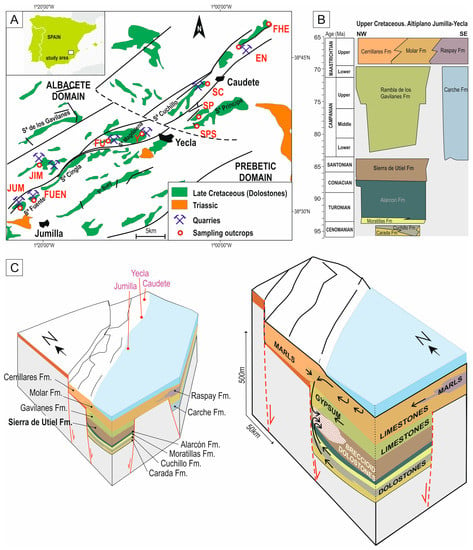
Figure 1.
(A) Distribution of the late Cretaceous outcrops in the study area where exploitations of the “Marrón Emperador” ornamental stones are concentrated. The Mesozoic tectosedimentary domains of the Betic Margin, the main tectonic accidents and the situation of the studied sections are indicated. (B) Chronostratigraphic chart of the upper Cretaceous lithostratigraphic units in the Jumilla-Yecla region (based on [38,44]). (C) Distribution scheme of upper Cretaceous materials in the study area where the nature of the materials associated with the brecciated dolostone geobody is indicated. Section/quarries/outcrops: FHI-Fuente la Higuera (Valencia); EN-La Encina (Alicante); SC-Sierra del Cuchillo (Albacete); SP- and SPS-Sierra del Príncipe (Murcia); Y-Sierra de la Magdalena Este (Yecla, Murcia); FU-Sierra de la Magdalena Oeste (Murcia); JIM-Sierra de la Cingla (Murcia); FUEN-Sierra de la Fuente (Murcia); JUM-Jumilla (Murcia).
2.1. Breccia Types and Spatial Distribution of Dolomitic Breccia Bodies
Crackle packbreccias (CB), mosaic packbreccias (M) and chaotic or ‘rubble’ floatbreccias (RB) are widely represented in all sectors of the study area (Table 2). Associated with them, other types of clast-supported breccia facies with a more local spatial distribution have been recognised: complex brecciated facies (Mv), in which several brecciation phases are recognised, and micritic mosaic packbreccia with incipient dolomitization (Mm).

Table 2.
Characteristics of breccia facies in the study area. Modified from Muñoz-Cervera et al. [7].
Crystalline carbonate cements that constitute a network of white veins and venules of different development frequently surround dolostone clasts. These white networks occur mainly in the clast-supported breccia facies (crackle and mosaic packbreccias). Multiple phases of calcite cementation are recognised, mainly composed of micro- to mesocrystalline calcite crystals (50–800 μm) showing blocky or drusy textures. In some cases, calcite cements grow on previous idiotopic to subidiotopic mesocrystalline dolomite cements (50–250 μm). Reddish calcite veins enriched in clay are relatively abundant in some mosaic breccia types (Mv, Mm). Likewise, some small micritic-clay fill and/or ferruginous patina associated with the cements are observed. Fine-grained matrix has a lighter coloration than dolomite clasts and is mainly composed of dolosparite and dolomicrite grains, with a very scarce presence of siliciclastic grains (e.g., quartz). Locally, this matrix is relatively rich in clays and/or iron oxide-hydroxides.
2.2. Dolostone Petrography and Geochemistry
Table 3 shows the main characteristics of the dolostone fabrics recognised in breccia clasts. The predominant dolomite fabrics recognised in breccia clasts are: (1) medium- to coarsely-crystalline dolosparites composed of hypidiotopic (planar-s) mosaics with crystals rich in impurities (Figure 2); (2) idiotopic (planar-e) mosaics; (3) and microcrystalline types. In these fabrics, the dolomite crystals sometimes show rhombic and subrhombic zones (delimited by alignments of inclusions or impurities) (Figure 2A–C) or simply emphasised nuclei (more or less of rhombic morphology), being common in the existence of limpid borders, either in planar-s or planar-e dolosparites. Ghosts of allochems and venules are relatively frequent (Figure 2B), as well as textures of mimetic and nonmimetic dedolomitization. Another abundant and relevant textural characteristic in these materials is the existence of styloliths (Figure 2D,E).

Table 3.
Main features of dolostone petrofabrics (modified from Muñoz-Cervera et al. [7]).
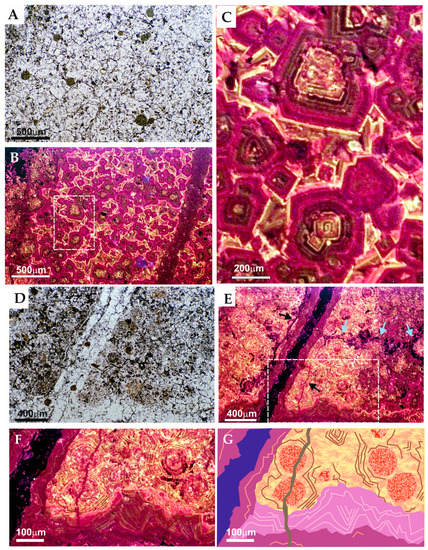
Figure 2.
(A,B) Hypidiotopic dolosparite mosaic. Replacive dolomite crystals show subrhombic cores (DOL-1) and rhombic-zoned cortex (DOL-2). (C) Detail of (B) micrograph. (D,E) Several phases of carbonate cements delineating fractures. Two generations of cements: dolomite cement (DC-1) and calcite cement (CC-1). Stylolite (blue arrows) and thinner calcite venules (black arrows) arranged parallel to the main carbonate vein can be observed. (F,G) Detail of (E) micrograph. (A,D) view in transmitted light. (B,C,E,F) view under cathodoluminescence.
The dolostone facies have different contents in carbonate mineral phases (calcite and dolomite) (Table 2 and Table S1) and generally show very low content in other types of minerals (<5% in quartz, feldspar of clays) [7,29,31]. The ‘crackle’ breccias show the highest percentages of dolomite (85–90%). Mosaic and chaotic (rubble) breccias also have high contents of dolomite, but it must be considered that both matrix and cements, at least partially, may have a dolomitic composition. The matrix-supported types (rubble breccia) are the richest in calcite, reaching 45%. Both the calcite crystals associated with dolosparites, as well as those that make up venules and speleothems are LMC (<4% molMgCO3). The analysed dolomites are not stoichiometric and show an enrichment in Ca, with % molCaCO3 values ranging from 50.3 to 56.1 (62% of samples between 53 and 55% molCaCO3). No relation between the stoichiometry of the dolomites, the dolomite textural types or the breccia fabric has been recognised. Regarding the degree of ordering of the dolomites, a direct relationship with their stoichiometry is not observed [7]. The main recognised breccia types show the same variability in the degree of ordering; it can only be noted that the dolosparitic mosaics associated with the ‘crackle’ breccias appear less ordered.
XRF analysis corroborates that the studied dolomites are Ca-rich (geochemical data from Table S1—Supplementary Materials, Muñoz-Cervera et al. [7]). Si and Al contents are also low, indicating the scarce presence of silicate phases in the studied materials. Both Fe and Mn content are relatively low (Fe2O3 between 0.1 and 0.42%; Mn below 100 ppm in most samples). Cl contents in dolosparites are relatively low (>250 ppm), although the dolomicrosparitic subtype shows a greater range of composition (100–450 ppm). On the contrary, Na concentration is relatively high (220–3100 ppm). Sr in the dolomitic phases varies between 132 and 268 ppm, presenting a good correlation with both Mg and Ca contents. However, no discrimination of the aforementioned groups (breccia types, dolomitic petrographic types) is observed in terms of Sr content. Calcite and dolomite cements show similar values in Fe content but significantly lower values in Si, Al, Na and K. As in dolomite clasts, the relatively high Sr values (175–610 ppm) also stand out.
3. Materials and Methods
Samples of Marrón Emperador geobody were selected from different quarries and outcrops located at the NNE-SSW (Altiplano Jumilla-Yecla) morphostructural alignment in the provinces of Alicante, Valencia and Murcia (SE Spain) (Figure 1). Morrow [45] and Mort et al. [46] classification schemes were used for the description of the breccia facies. Thus, the main breccia types have been discriminated between clast-supported breccia and matrix-supported breccia, as well as the degree of concentration/rotation of the clasts (from crackle, mosaic and rubble breccia types) and the existence and nature of matrix and/or cement in interfragmental position.
More than a hundred samples, representative of all textural types, were selected for thin section preparation and petrographic analysis. Thin sections were obtained by standard methods and observed under a Zeiss Axiscop microscope for the definition of compositional and textural features. Potassium ferricyanide and alizarin red S staining methods were used to distinguish carbonate minerals [47]. The classification and description of dolomitic textures were performed according to Gregg and Sibley [48] and Friedman [49] nomenclature schemes. Thirty-eight thin sections were analysed with cathodoluminescence (CL) microscopy with a Citl Cold Cathode Luminiscence 8.200 cold-cathode instrument (Geology Department, Salamanca University, Salamanca, Spain), mounted on a binocular petrographic microscope (Labophot 2-Pol, Salamanca University, Salamanca, Spain), equipped with 4× and 10×·objectives and a trinocular photohead with 10× oculars. Operating voltages were held at 15–20 kV and gun current levels at 200–400 mA.
An oxygen- and carbon-stable isotopic composition was analysed from 55 dolomite and calcite diagenetic phases. Sampling was performed with a microdrill equipped with 0.4e1-mm-diameter bits. Powdered calcite and dolomite preparations were reacted with phosphoric acid for 10 min, respectively, in vacuum at 90 °C. The evolved CO2 was analysed in a VG-Isotech SIRA IITM mass spectrometer at the Sciences Faculty laboratories (Salamanca University, Spain). Results were corrected and expressed in ‰ relative to standard Vienna Pee Dee Belemnite (V-PDB). The precision and reproducibility of both isotopic analyses were ±0.02‰ for δ13C (V-PDB) and of ±0.12‰ for δ180 (V-PDB).
4. Results
4.1. Petrography
Through the study of the cathodoluminescence of the samples, it has been possible to recognise various types and phases of replacement and cementation in the diagenetic history that have affected the ME breccia dolostones. The CL pattern of the dolomite crystals from breccia clasts reveals generations of their growth (Table 4 and Table 5).

Table 4.
Petrography and CL pattern of replacing dolomites in the ME brecciated dolostone geobody.

Table 5.
Petrography and CL pattern of dolomite and calcite cements in ME dolostone geobody.
Both in the dolosparite fabrics that show zoned (rhombic to subrhombic) or emphasized cores, as well as in those that have a lack of impurities, dolomite crystals show homogeneous or mottled dull red to red luminescence (DOL-1) (Figure 2 and Table 4). These crystals or cores usually show corroded borders. Growing syntaxially on these cores, the following defined dolomitic type (DOL-2) occurs (Figure 2 and Table 4). This type generally has subeuhedral shapes and a marked rhombic zoning formed by bands of different luminescence, as well as a smaller number of impurities (clear crystals in many cases). The type of luminescence of these zones and their sequence vary according to samples and zones, reflecting a complexity in the compositional evolution of the dolomitizing fluids. DOL-1 and DOL-2 crystals often coalesce embedded in another dolomitic phase (dolomite cement 1; CD-1) (Figure 2) with a variable concentric luminescence. These are rhombic overgrowths in optical continuity with the crystals they enclose, either totally or partially, but generally only developed in the parts of the crystals that border on pores (intercrystalline, moldic, etc.). These crystals, in addition to filling intercrystalline porosity, also outline fractures and venules (ghosts) (Figure 2D–G). These cements have euhedral terminations when there is space and typical flat limits (compromise boundaries) when they completely fill the pores. Locally, planar-s and nonplanar-s type dolomitic cements have been recognised, with a characteristic blue luminescence that has been attributed to “saddle” or baroque type cements (CD-2) (Figure 3A,B).
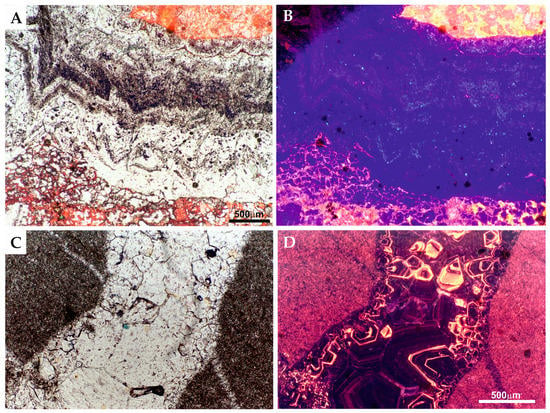
Figure 3.
Transmitted light images (on the left) placed against cathodoluminescence properties (on the right) of different cement phases in dolostone facies. (A,B) Dolomite saddle type cement (CD-2) showing multiple zones of bright blue to dull luminescence. (C,D) Calcite cement (CC-2) showing fine bright orange, yellow or dull red luminescent bands.
Calcite cements are ubiquitous and generally have little or no luminescence. Texturally, the existence of multiple phases of calcite cementation has been recognised in many of the studied sections. These cements basically consist of: (i) simple syntaxial rhombic overgrowths that totally or partially embrace subhedral-euhedral dolomite crystals (with evidence of dissolution and/or fracturing) or (ii) overgrowths that encompass several crystals (cluster), forming isopaque type cements. Both types are associated with and/or delineate porosity. From their CL pattern, two types have been defined (Table 5): CC-1, with zero or practically zero luminescence (Figure 2), and CC-2, with the presence of fine bright yellow or dull red luminescent bands (Figure 3C,D).
Several phases of brecciation also have been detected, with doloesparitic, recrystallized breccia that are composed of clasts that, in turn, are chaotic or mosaic-type breccia, where elements of the previous paste (matrix, cement) can be distinguished (Figure 4).
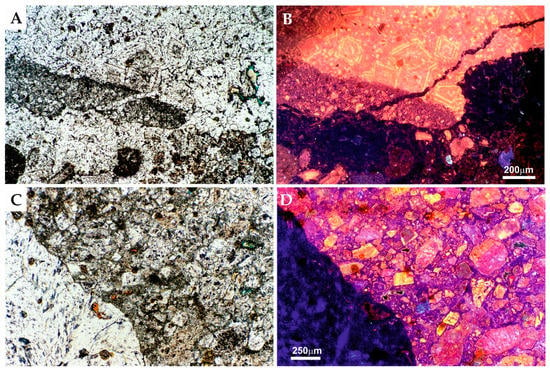
Figure 4.
Transmitted light images (on the left) placed against cathodoluminescence properties (on the right) of different brecciation phases in dolostone facies. (A,B) Mosaic breccia clast composed of dolosparite (DOL-2) mosaic. CL patterns show the existence of “ghosts”: venule-type cement (CC-1) that delineate and traverse the dolosparite clast, areas with micritic matrix and dolosparitic grains. (C,D) Detail of rubble breccia clast composed of dolosparitic fragments (DOL-1, DOL-2) in a micritic matrix. In CL, we can see calcite cement (CC-1) and a fragment of a dolosparitic breccia composed, in turn, of dolosparite clasts with different CL patterns: rounded clasts with dull red-brown luminescence and bright mottles (DOL-1) and fragments of rhombic crystals with luminescent zoning (DOL-2).
4.2. Geochemistry
Most of the materials, both those of a calcitic nature and the dolomites, have a light composition in stable isotopes of carbon and oxygen, with values of δ13C between −1 and −11‰ and of δ18O between 1 and −9‰ (Figure 5 and Table S1). Brecciated dolomites have values of δ13C values ranging between −1.5 and −6.5 and δ18O values ranging between 0.5 and 2.5‰. No significant discrimination was observed based on the type of dolomite or breccia or on the spatial distribution of the samples, which probably indicates a common genesis, both in the dolomitization mechanism and in its age. The calcite crystals found in dolomitic mosaics, whether relicts or the result of dedolomitization products show an isotopic composition similar to that of dolomites as a whole, with values of δ13C ranging between −1 and −7‰ and of δ18O between 0 and −3‰. However, the isotopic composition of calcite venules and speleothems is markedly lighter, both for oxygen (δ18O: −4 to −8‰) and carbon (δ13C: −6 to −11‰).
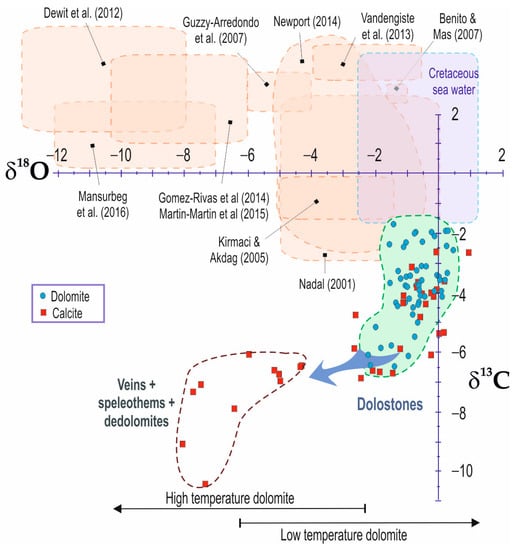
Figure 5.
Cross plot of stable δ13C(V-PDB) versus δ18O(V-PDB) values of samples from the ME brecciated dolostone geobody. δ18O ranges for high and low temperature marine dolomites are based on a compilation from Allan and Wiggins [50]. The compositional ranges of other examples of Cretaceous dolomitic bodies are included: Catalan Coastal Range, Spain [51]; Maestrat Basin, Spain [13,52]; Iberian Chain, Spain [53,54], Basque Cantabrian Basin, Spain [17]; Cupido Fm., Mexico [55]; Habshan Fm., Oman [56]; Zagros Basin, Irak [57]; Eastern Pontides, Turkey [58].
5. Discussion
As shown in Figure 1, there is an almost exclusive distribution of brecciated dolostone facies in a narrow strip along the Jumilla-Yecla-Caudete-Fuente de la Higuera structural alignment. This tectonic alignment strongly controlled sedimentation in some upper Cretaceous intervals [40,42] but also played a major role in the dolomitization and brecciation processes [31,36,59]. Likewise, the distribution of the dolomitic bodies is consistent with the nonearly nature of the dolomitization. The spatial connection between dolostones and breccia may reflect a close relationship between the dolomitization and brecciation processes. However, at the outcrop scale, the limits of the dolomitic bodies are irregular, locally exceeding the limits of the Sierra de Utiel Fm. itself. The limestones that surround the dolomitic body locally are also brecciated, indicating that: (i) brecciation and dolomitization are not genetically related or, (ii) at least one phase of brecciation is subsequent to the dolomitization of the Sierra de Utiel Limestones Fm.
5.1. Dolomitization Process
The close spatial relationship of the dolomitic bodies with the main structural alignments of the basin in the Cretaceous led to a tectonically or structurally controlled circulation of fluids. The flow of fluids through tectonically active faults is episodic in nature [60,61,62], so extensive dolomitization requires many such flow episodes [20,63,64].
The main recognised dolomitic textural types (hypidiotopic planar-s, idiotopic planar-e) are consistent with a late nonmimetic dolomitization at low temperatures [48]. Likewise, the presence of limpid cortex indicates the existence of slow replacement phases without the incorporation of impurities from the original sediment or overgrowth phases (syntaxial cementation) on the dolomite cores [60,61]. The δ18O values of dolomites reflect the isotopic composition and temperature of dolomitizing fluids [58,65,66,67,68]. The δ18O composition of the ME dolomitic textures is very similar (−2.5–1.0‰ V-PDB), and these values differ from those that would be obtained in dolomites precipitated from Cretaceous marine water (0–3‰, [69]) (Figure 5), so that a primary or early origin for these dolomites can be ruled out. Using the diagrams elaborated by Gasparrini et al. [70], which are based on the fractionation equations of land [71] for dolomite and Friedman and O’Neil [72,73] for calcite, an approximation of the isotopic composition (oxygen) and formation temperatures of carbonate phases has been performed. The results indicate that the formation temperatures of the different dolomitic (replacement, cement) and calcitic (cementation, dedolomitization) textural types do not exceed 50–60 °C according to the paleotemperature equations used, whether the nature of the fluids has a meteoric or saline influence (derived from marine waters or basin geofluids). Even considering a heavier isotopic composition for marine waters in these equations, in the case of deep dolomitization, the resulting temperatures would not enter the typical range of hydrothermalism. The existence, although volumetrically scarce, of saddle dolomite in void-filling mode (CD-2) may indicate some episode of higher temperature (hydrothermal tectonic dolomitization) [48]. With these formation temperatures, without another source of heat (e.g., magmatic intrusions), and with normal geothermal gradients (25–40 °C/km), dolomitization would have occurred at relatively shallow burial depths (0.6–1 km). Stylolites in dolostones, which can act as conduits for dolomitization fluids, appear to require at least 400–500 m of burial [74,75,76]. The isotopic composition of the ME dolostones clearly differs from other Cretaceous dolostones that were generated by interaction with diagenetic fluids with lower salinity and/or higher temperatures (Figure 5).
CL examination evidences the multiphase character of dolomitization, such that several types (and phases) of replacement and cementation have been recognised within the dominant dolosparitic mosaics. The nuclei of the rhombic and subrhombic crystals (DOL-1) show a high content of impurities, and after a dissolution phase (corroded borders); they are syntaxially overgrown by a dolomite (DOL-2). These crystals are generally less rich in impurities. DOL-2 constitutes a series of more or less thick concentric bands or envelopes (1–10 μm to 300 μm) with different luminescence. This may reflect multiple stages of regrowth or microenvironmental changes. The next phase of dolomite formation (CD-1), such as DOL-2, occurs in the form of syntaxial overgrowths on the previous dolomitic crystals, in this case, DOL-2, but unlike the latter, it is distributed as cements, embedding and binding previous crystals (isolated or in groups) or simply filling porosity. In some studies (see Choquette and Hiatt [77] for a review), this type is not referred to as cement, but as a further replacement or recrystallization phase. The existence of dolomite cements has a great influence on the progress and effectiveness of dolomitization processes, since they can drastically reduce the porosity and permeability of the host rock by more than two orders of magnitude [77,78]. Some dolomite textural types show uniform luminescence (absence of zoning), especially in micritic-microsparitic fabrics and in the nuclei of dolosparitic crystals. This is indicative of a low variation in the composition of the fluids responsible for their formation, which translates into a homogeneous composition (Mg/Ca ratio and trace elements). This reflects that the replacement and cementation processes do not have a significant influence on the composition of the fluids; that is, the water/rock ratios are high, and it is an open system. However, the existence of different types of replacive dolomites and cements (ghosts under a petrographic microscope), both calcitic (lithification) and dolomitic (dolomitization/dolomitic cementation), is indicative of the existence of various phases of Mg-rich fluids going through a previous permeable material.
Considering the structural, textural and compositional characteristics of the ME dolostones geobody and taking into account the nature of the adjacent rocks (Figure 1 and Figure 6), the magnesium required for dolomitization may have derived from the different sources or fluids: (i) marine waters or waters derived from seawater, more or less concentrated or evolved; (ii) residual hypersaline brines, derived from those previously mentioned, which imbibe the sediments subject to diagenetic alteration; (iii) fluids derived from the mechanical compaction of the underlying Cretaceous carbonate and marly series; (iv) fluids that have calcitized underlying Cenomanian dolomites; (v) fluids derived from the alteration of overlying marl-clay materials (upper Maastrichtian); or (vi) Mg-rich brines derived from the dissolution of Triassic materials (Keuper facies). Halite dissolution by Mg-rich fluids would increase the salinity of mineralizing fluids [79,80]. Considering the volume of the dolomitized geobody, of all those mentioned, only marine waters or fluids derived from marine waters can constitute a sufficient source of magnesium to produce massive dolomitization. However, the compositional complexity of the studied materials may reflect the existence of various sources of dolomitizing fluids. The Sr content of the samples studied is consistent with dolomitization at depth related to more or less saline waters [81,82,83,84,85,86]. The relatively high Na content of the studied dolomites is in contrast to the relatively low Sr content, interpreted in terms of the nature of the dolomitizing fluid (hypersaline vs. mixing). In the case of ME dolostones, there is another source rich in Na that may be related to some diagenetic stage (dolomitization, dedolomitization, recrystallization, etc.), such as the Triassic diapiric bodies that are discontinuously arranged but adjacent to the SE of the brecciated geobodies.
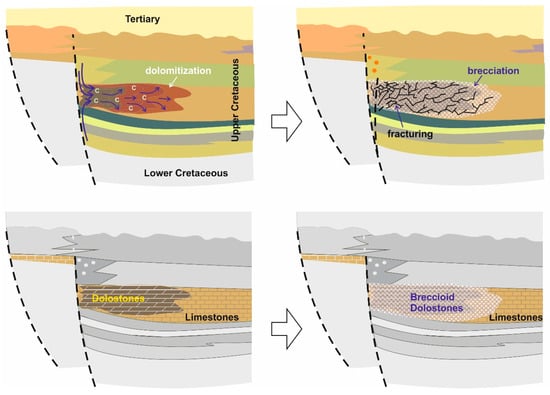
Figure 6.
Conceptual integrative model for the formation of the ME breccioid dolostones. See the distribution of upper Cretaceous lithostratigraphic formations in Figure 1C.
The complexity of textures and compositions observed in ME dolostones reflects that the fault and fracture system that carried the dolomitizing fluids was heterogeneous, supporting variable flows, and leading to variable rates of fluid cooling and mixing and different degrees of water-rock interaction. A key aspect of these styles of dolomitization, which is very well observed in the case study, since it largely explains the textural complexity (replacements, dissolutions, cementations, dedolomitizations, brecciation, etc.), is that dolomitization occurs after burial and lithification (syndiagenesis, early diagenesis) of the original calcareous sediment. Moreover, the dolomites that make up the dolomitized body have precipitated directly as cement or replaced the original material. Of all the dolomitization models that can be considered for the case study, the one that best fits the characteristics of the materials studied is that of tectonic (structurally controlled) influence. In the scientific literature, there are abundant examples of stratiform dolomitization associated with faults that act as feeders of dolomitizing fluids [10,11,12,13,18,27,28,70,87]. The result is the formation of stratiform dolomite geobodies several tens of metres thick and kilometres long (SW-NE direction), that have probably encompassed and erased the fault network that acted as fluid feeding points. Precise estimates cannot be made with current data regarding the properties (length, hydraulic opening, connectivity, segmentation, etc.) of this network of faults and fractures, although the large volume of dolostones formed is evidence of the effectiveness of the system.
5.2. Brecciation Processes
The brecciated bodies are stratiform on a large scale, with irregular limits and a great spatial continuity. The main types of breccias identified (crackle- and mosaic-clast-supported breccias and chaotic or rubble matrix-supported breccias) are widely represented in all sectors of the study area. These types are generally spatially associated at different scales and, in most cases (when more than two of these types coexist in an outcrop), it has not been possible to delimit separate geometric distributions.
A main characteristic of these rocks, which even contributes to their aesthetic value as an ornamental rock, is that calcite crystalline cement surround the clasts. The formation of calcitic (and, to a lesser extent, dolomitic) fills in the form of venules reflects an extensive circulation of fluids through fractures that can occur in various phases of the genetic history of the materials, reflecting the origin and geochemical evolution of the materials and fluids during the thermotectonic evolution of the sedimentary basin [88,89]. The existence and predominance (in ‘crackle’ and mosaic-type brecciated facies) of calcitic venules and veins and the texture of their fillings (equidimensional or ‘blocky’ mosaics) provide data on the genesis of these materials:
- In facies where cement dominate, regardless of the type of brecciation mechanism considered, a dilation process has occurred during fragmentation. In this sense, we could take into account the concept of dilation breccias [90].
- Blocky textures imply a filling of a pre-existing hole, contrary to the fibrous textures in venules that are indicative of filling during the opening of the fractures [91].
- Blocky textures also tend to indicate rapid brecciation [92]. The fibrous textures would be more indicative of a slow opening of holes or brecciation.
- All textures are phreatic. Only textures that can be interpreted as vadose have been recognised in complex breccia types (e.g., Mv).
- The predominant existence of a single cementation phase in all types of venules (different sizes and orientations, for example) favours the existence of a single and probably rapid fracturing phase (brecciation). However, by cathodoluminescence, it has been possible to observe some venules with more than one cementation phase.
- Locally, transgranular fractures have been observed parallel to venules filled by one or more cement phases that could be related to crack-seal processes in which fluid overpressure plays a major role in their genesis [93,94]. However, other typical textures, such as fibrous cements, calcite bridges, etc., have not been observed [95,96,97,98].
Multiple phases of calcitic cementation are recognised, in some cases taking advantage of or leaning on previous dolomitic cements. Figure 2D–G illustrate smaller calcite venules arranged parallel to the main dolomitic-calcitic vein.
All types of breccias recognised in this study have been described in different contexts and attributed to various genetic mechanisms, from intraformational breccias by the dissolution of interbedded evaporites in the series, to fault breccias or breccias of hydrothermal origin [9,46]. In themselves, these typologies, based mainly on the degree of concentration of clasts and the degree of fit between them, do not indicate a specific origin for each one of them. However, the high degree of clast fit and gradation between types is a clear argument for a diagenetic origin [99]. The lack of evidence of evaporite dissolution, the nonstratiform geometry of the brecciated bodies or the compositional homogeneity of the matrix in the brecciated facies exclude a penecontemporaneous origin, by collapse (evaporite dissolution) or karstic dissolution, for the brecciated dolostones. The dominant crackle-mosaic breccia fabric, with angular-shaped clasts suggesting limited transport of the fragments, the geometry of breccia bodies and the widespread calcite cementation of large extensional veins and calcite breccia fill, are typical features of hydraulic expansion of a fractured host rock (hydraulic breccia) [9,20,46,100]. The formation of these breccias implies that the fracturing has occurred or has been promoted by differential stresses, even if they are low or intermittent: fluid pressure builds up to exceed the tensional strength of the rock and cause failure, after which flow can occur until the fracture permeability is sealed off again [101]. Repeated fracturing in the form of clasts and brecciated cement was observed in ME dolostone breccias (Figure 4). This abnormally high fluid pressure can be due to a number of reasons: rapid burial in basins with high sedimentation rates, tectonic deformations due to fluid migration, mineralogical transformations, etc. [9,14,20,21,90,91,92]. The increase in fluid pressure and opening of hydrofractures formed in extensional settings (structurally controlled dolomites, SCD) indicate an important tectonic control.
5.3. Diagenetic (Paragenetic) Sequence
Field and analytical data indicate that the diagenetic evolution of the ME brecciated dolostones involve alterations occurring at shallow burial (early calcite cementation, early dolomitization), intermediate to deep burial (compaction, dolomitization of the host limestones, hydraulic brecciation and carbonate cementation) and during uplift (dedolomitization, late calcite cementation, karst collapse brecciation) (Figure 7). The main phases of dolomitization and brecciation occurred during mesodiagenesis with the input through styloliths and fractures of dolomitizing fluids of diverse origin (evolved marine, dissolution of overlying and underlying dolomites, and alteration of marl-clay materials). The fluid flow model has a structural control (Figure 6), with the dolomitizing fluids reaching the host rock in fracture zones and normal faults and advancing through it, forming a stratiform dolomitic body with irregular geometry. Subsequently, different phases of hydraulic fracturing generate the brecciated body in the dolomitic materials.
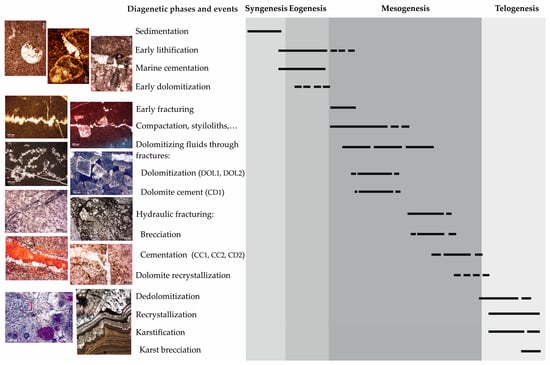
Figure 7.
Paragenetic sequence of the ME brecciated dolostones showing the relative timing of most important diagenetic phases.
6. Conclusions
The petrological and geochemical data indicate that the ME brecciated dolostones exhibit a diagenetic paragenesis consisting of dolomitization of the host limestone (Sierra de Utiel Fm.), brecciation and carbonate cementation. The bulk of the dolostone is formed by coarsely crystalline dolosparites composed of hypidiotopic (planar-s) and (planar-e) mosaics. Intergranular and fracture (stylolitization) porosity strongly controlled the dolomitization processes. Dolomitization and later processes (neomorphic recrystallization, cementation) occurred in relation to successive fluid flows along the higher permeability zones. Petrographic and geochemistry data suggest that the dolomitization took place in relatively low-temperature fluids, likely at temperatures not exceeding 60 °C, and in shallow burial (0.6–1 km). Dolostone distribution indicates that the replacement of the Sierra de Utiel Fm. limestones were structurally controlled by basement faults that operated as feeding points for the dolomitizing brines. Likewise, the spatial distribution of breccia geobodies and their textural and compositional features (with a predominance of packbreccia types) indicate that brecciation was structurally controlled. Successive phases of hydraulic fracturing generate the brecciated geobody in the dolomitic materials and also in the limestones that surround the dolostone geobody. Multiple phases of calcitic (and, to a lesser extent, dolomitic) cementation reflect an extensive circulation of fluids through fractures that can occur in various phases of the paragenetic evolution of brecciated dolostone geobodies.
Supplementary Materials
The following supporting information can be downloaded at: https://www.mdpi.com/article/10.3390/app13095470/s1, Table S1: Mineral and isotopic composition (δ13C and δ180) of ME brecciated dolostone geobody.
Author Contributions
Conceptualisation, M.C.M.-C. and J.C.C.; investigation, M.C.M.-C. and J.C.C.; writing—original draft preparation, M.C.M.-C. and J.C.C.; writing—review and editing, J.C.C.; visualisation, M.C.M.-C.; supervision, J.C.C. All authors have read and agreed to the published version of the manuscript.
Funding
This research received no external funding.
Institutional Review Board Statement
Not applicable.
Informed Consent Statement
Not applicable.
Data Availability Statement
Not applicable.
Conflicts of Interest
The authors declare no conflict of interest.
References
- Warren, J. Dolomite: Occurrence, evolution and economically important associations. Earth-Sci. Rev. 2000, 52, 1–81. [Google Scholar] [CrossRef]
- Cantrell, D.; Swart, P.; Hagerty, R. Genesis and characterization of dolomite, Arab-D reservoir, Ghawar field, Saudi Arabia. GeoArabia 2004, 9, 11–36. [Google Scholar] [CrossRef]
- Davies, G.R.; Smith, L.B., Jr. Structurally controlled hydrothermal dolomite reservoir facies: An overview. Aapg Bull. 2006, 90, 1641–1690. [Google Scholar] [CrossRef]
- Reid, S.; Dewing, K.; Sharp, R. Structural and diagenetic origin of breccias in the carbonate-hosted Polaris Zn–Pb deposit, Nunavut, Canada. Ore Geol. Rev. 2013, 55, 110–124. [Google Scholar] [CrossRef]
- Shelton, K.L.; Cavender, B.D.; Perry, L.E.; Schiffbauer, J.D.; Appold, M.S.; Burstein, I.; Fike, D.A. Stable isotope and fluid inclusion studies of early Zn-Cu-(Ni-Co)-rich ores, lower ore zone of Brushy Creek mine, Viburnum Trend MVT district, Missouri, USA: Products of multiple sulfur sources and metal-specific fluids. Ore Geol. Rev. 2020, 118, 103358. [Google Scholar] [CrossRef]
- Mitchel, C.; Bide, T.; Ellison, R.; Lott, G.; Lacinska, A.; Parry, S.; Entwisle, D. Assessment of the Dimension Stone Resources of the UAE; The Geology and Geophysics of the United Arab Emirates; British Geological Survey: Nottingham, UK, 2012; Volume 11, 212p. [Google Scholar]
- Muñoz-Cervera, M.C.; Rodriguez-Garcia, M.Á.; Cañaveras, J.C. Aesthetic Quality Properties of Carbonate Breccias Associated with Textural and Compositional Factors: Marrón Emperador Ornamental Stone (Upper Cretaceous, Southeast Spain). Appl. Sci. 2022, 12, 2566. [Google Scholar] [CrossRef]
- Blount, D.N.; Moore, C.H. Depositional and non-depositional carbonate breccias, Chianthia quadrangle, Guatemala. Bull. Geol. Soc. Am. 1969, 80, 429–442. [Google Scholar] [CrossRef]
- Jébrak, M. Hydrothermal breccias in vein-type ore deposits: A review of mechanisms, morphology and size distribution. Ore Geol. Rev. 1997, 12, 111–134. [Google Scholar] [CrossRef]
- Machel, H.G. Concepts and models of dolomitization: A critical reappraisal. Geol. Soc. Lond. Spec. Publ. 2004, 235, 7–63. [Google Scholar] [CrossRef]
- Phillips, W.J. Hydraulic fracturing and mineralization. J. Geol. Soc. 1972, 128, 337–359. [Google Scholar] [CrossRef]
- Wilson, M.I.J.; Evans, M.J.; Oxtoby, N.H.; Nas, D.S.; Donnelly, T.; Thirwall, M. Reservoir quality, textural evolution, and origin of fault-associated dolomites. AAPG Bull. 2007, 91, 1247–1272. [Google Scholar] [CrossRef]
- Martin-Martin, J.D.; Trave, A.; Gomez-Rivas, E.; Salas, R.; Sizun, J.P.; Verges, J.; Corbella, M.; Stafford, S.L.; Alfonso, P. Fault-controlled and stratabound dolostones in the Late Aptian–earliest Albian Benassal Formation (Maestrat Basin, E Spain): Petrology and geochemistry constrains. Mar. Pet. Geol. 2015, 65, 83–102. [Google Scholar] [CrossRef]
- Shukla, M.K.; Sharma, A. A brief review on breccia: It’s contrasting origin and diagnostic signatures. Solid Earth Sci. 2018, 3, 50–59. [Google Scholar] [CrossRef]
- Koeshidayatullah, A.; Corlett, H.; Stacey, J.; Swart, P.K.; Boyce, A.; Robertson, H.; Whitaker, F.; Hollis, C. Evaluating new fault-controlled hydrothermal dolomitization models: Insights from the Cambrian Dolomite, Western Canadian Sedimentary Basin. Sedimentology 2020, 67, 2945–2973. [Google Scholar] [CrossRef]
- Gasparrini, M.; Bakker, R.J.; Bechstädt, T. Characterization of dolomitizing fluids in the Carboniferous of the Cantabrian Zone (NW Spain): A fluid-inclusion study with cryo-Raman spectroscopy. J. Sed. Res. 2006, 76, 1304–1322. [Google Scholar] [CrossRef]
- Dewit, J.; Huysmans, M.; Muchez, P.; Hunt, D.W.; Thurmond, J.B.; Verges, J.; Saura, E.; Fernandez, N.; Romaire, I.; Esestime, P.; et al. Reservoir characteristics of fault-controlled hydrothermal dolomite bodies: Ramales Platform case study. In Advances in Carbonate Exploration and Reservoir Analysis; Special Publications; Garland, J., Neilson, J.E., Laubach, S.E., Whidden, K.J., Eds.; Geological Society, London: London, UK, 2012; Volume 370, pp. 83–109. [Google Scholar]
- Hollis, C.; Bastesen, E.; Boyce, A.; Corlett, H.; Gawthorpe, R.; Hirani, J.; Rotevatn, A.; Whitaker, F. Fault-controlled dolomitization in a rift basin. Geology 2017, 45, 219–222. [Google Scholar] [CrossRef]
- Stacey, J.; Corlett, H.; Holland, G.; Koeshidayatullah, A.; Cao, C.; Swart, P.K.; Crowley, S.; Hollis, C. Regional fault-controlled shallow dolomitization of the Middle Cambrian Cathedral Formation by hydrothermal fluids fluxed through a basal clastic aquifer. Gsa Bull. 2021, 133, 2355–2377. [Google Scholar] [CrossRef]
- Sibson, R.H. Brecciation processes in fault zones, Interferences from earthquake rupturing. Pure Apl. Geophys. 1986, 124, 149–175. [Google Scholar]
- Belza, J.; Alvarez, W.; Tavarnelli, E.; Vanhaecke, F.; Baele, J.-M.; Claeys, P. Expansion breccias in Lower Cretaceous Apennine pelagic limestones: II. Geochemical constraints on their origin. In 250 Million Years of Earth History in Central Italy: Celebrating 25 Years of the Geological Observatory of Coldigioco; GSA Spec. Paper 542; Koeberl, C., Bice, D.M., Eds.; Geological Society of America: Boulder, CO, USA, 2019; pp. 251–269. [Google Scholar]
- Lopez-Horgue, M.A.; Iriarte, E.; Schroder, S.; Fernandez-Mediola, P.A.; Caline, B.; Corneyllie, H.; Fremont, J.; Sudrie, M.; Zerti, S. Structurally controlled hydrothermal dolomites in Albian carbonates of the Ason valley, Basque Cantabrian Basin, Northern Spain. Mar. Pet. Geol. 2010, 27, 1069–1092. [Google Scholar] [CrossRef]
- Shah, M.M.; Nader, F.H.; Dewit, J.; Swennen, R.; Garcia, D. Fault-related hydrothermal dolomites in Cretaceous carbonates (Cantabria, northern Spain): Results of petrographic, geochemical and petrophysical studies. Bull. Soc. Geol. Fr. 2010, 181, 391–407. [Google Scholar] [CrossRef]
- Sharp, I.; Gillespie, P.; Morsalnezhad, D.; Taberner, C.; Karpuz, R.; Verges, J.; Horbury, A.; Pickard, N.; Garland, J.; Hunt, D. Stratigraphic architecture and fracture-controlled dolomitization of the Cretaceous Khami and Bangestan groups: An outcrop case study, Zagros Mountains, Iran. In Mesozoic and Cenozoic Carbonate Systems of the Mediterranean and the Middle East: Stratigraphic and Diagenetic Reference Models; van Buchem, F.S.P., Gerdes, K.D., Esteban, M., Eds.; Geological Society: London, UK, 2010; Volume 329, pp. 343–396. [Google Scholar]
- Di Cuia, R.; Riva, A.; Scifoni, A.; Moretti, A.; Spotl, C.; Caline, B. Dolomite characteristics and diagenetic model of the Calcari Grigi Group (Asiago Plateau, Southern Alps—Italy): An example of multiphase dolomitization. Sedimentology 2011, 58, 1347–1369. [Google Scholar] [CrossRef]
- Lapponi, F.; Casini, G.; Sharp, I.; Blendinger, W.; Fernandez, N.; Romaire, I.; Hunt, D. From outcrop to 3D modelling: A case study of a dolomitized carbonate reservoir, Zagros Mountains, Iran. Pet. Geosci. 2011, 17, 283–307. [Google Scholar] [CrossRef]
- Koeshidayatullah, A.; Corlett, H.; Stacey, J.; Swart, P.K.; Boyce, A.; Hollis, C. Origin and evolution of fault-controlled hydrothermal dolomitization fronts: A new insight. Earth Planet. Sci. Lett. 2020, 541, 116291. [Google Scholar] [CrossRef]
- Koeshidayatullah, A.; Corlett, H.; Hollis, C. An overview of structurally-controlled dolostone-limestone transitions in the stratigraphic record. Earth-Sci. Rev. 2021, 220, 103751. [Google Scholar] [CrossRef]
- García del Cura, M.A.; Rodríguez, M.A.; Pina, J.A.; Cañaveras, J.C.; Baltuille, J.M.; Ordóñez, S. Los mármoles comerciales “Marrón Imperial” y “Marrón Emperador” (S.E. España). Caracterización petrológica y criterios de exploración. Bol. Geol. Min. 1999, 110, 67–76. [Google Scholar]
- Rodríguez García, M.A.; García del Cura, M.A.; Muñoz Cervera, M.C.; Cañaveras, J.C. Recursos de rocas ornamentales en los términos de Jumilla y Yecla (Murcia). Macla 2005, 3, 173–175. [Google Scholar]
- Muñoz-Cervera, M.C.; Rodríguez-García, M.A.; García del Cura, M.A.; Cañaveras, J.C. Dolomías brechoides ornamentales (Marrón Emperador) del Cretácico superior de la Sierra del Cuchillo (Albacete). Geotemas 2007, 10, 1171–1174. [Google Scholar]
- Cueto, N.; Benavente, D.; García del Cura, M.A. Estimation of water permeability of building brecciated dolostones. In Proceedings of the 7th International Symposium on the Conservation of Monuments in the Mediterranean Basin “Water and Cultural Heritage”, Orleans, France, 6–9 June 2007; pp. 119–129. [Google Scholar]
- Benavente, D.; Martínez-Martínez, J.; Cueto, N.; García del Cura, M.A. Salt weathering in dual-porosity building dolostones. Eng. Geol. 2007, 94, 215–226. [Google Scholar] [CrossRef]
- Cueto, N.; Benavente, D.; García del Cura, M.A. Influence of anisotropy on rock hydrical properties. Analysis of brecciated dolostones from Betic Cordillera (Spain). Geogaceta 2006, 40, 315–318. [Google Scholar]
- Cueto, N.; Benavente, D.; Martínez-Martínez, J.; García del Cura, M.A. Rock fabric, pore geometry and mineralogy effects on water transport in fractured dolostones. Eng. Geol. 2009, 107, 1–15. [Google Scholar] [CrossRef]
- Muñoz-Cervera, M.C.; García del Cura, M.A.; Cañaveras, J.C. Caracterización isotópica (δ13C y δ18O) de las dolomías brechoides del Cretácico Superior del Prebético Externo en el sector Jumilla-Yecla. Macla 2007, 7, 51. [Google Scholar]
- Del Pozo, J.R.; Martín-Chivelet, J. Bioestratigrafía y cronoestratigrafía del Coniaciense-Maastrichtiense en el sector Prebético de Jumilla-Yecla (Murcia). Cuad. Geol. Ibérica 1994, 18, 83–116. [Google Scholar]
- Luperto Sinni, E.; Martin Chivelet, J.; Giménez, R. Praemurgella valenciana nov. gen. et sp. (Foraminifera) in the Sierra de Utiel Formation (Coniacian-Santonian) of the Prebetic Domain (SE Spain). Geobios 2000, 33, 145–151. [Google Scholar] [CrossRef]
- Vilas, L.; Arias, C.; García, A. El paso del Dominio Ibérico al Dominio Bético en la zona suroriental de Albacete. In El Cretácico de la Parte Oriental de la Provincia de Albacete; Complutense: Madrid, Spain, 1982; pp. 47–72. [Google Scholar]
- Martin-Chivelet, J. Las Plataformas Carbonatadas del Cretácico Superior de la Margen Bética (Altiplano de Jumilla—Yecla, Murcia). Ph.D. Thesis, Universidad Complutense de Madrid, Madrid, Spain, 1992; 899p. [Google Scholar]
- Martín-Chivelet, J.; Berástegui, X.; Caus, E.; Puig, C. Cretaceous. In Geology of Spain; Gibbons, W., Moreno, T., Eds.; Geological Society of London: London, UK, 2002; pp. 255–292. [Google Scholar]
- Martín-Chivelet, J. Late Cretaceous Stratigraphic Patterns and subsidence history of the Betic Continental Margin (Jumilla-Yecla region, SE Spain). Tectonophysics 1996, 265, 191–211. [Google Scholar] [CrossRef]
- Martín-Chivelet, J.; Chacón, B. Event-stratigraphy of the upper Cretaceous to lower Eocene hemipelagic sequences of the Prebetic Zone (SE Spain): Record of the onset of tectonic convergence in a passive continental margin. Sedim. Geol. 2007, 197, 141–163. [Google Scholar] [CrossRef]
- Vilas, L.; Martín-Chivelet, J.; Arias, C.; Chacón, B. Geología del Altiplano de Jumilla-Yecla. Geología. Enciclopedia divulgativa de la historia natural de Jumilla-Yecla. Soc. Mediterránea De Hist. Nat. 2005, 6, 17–177. [Google Scholar]
- Morrow, D.W. Descriptive field classification of sedimentary and diagenetic breccia fabrics in carbonate rocks. Bull. Can. Pet. Geol. 1982, 30, 227–229. [Google Scholar]
- Mort, K.; Woodcock, N.H. Quantifying fault breccia geometry, Dent Fault, NW England. J. Struct. Geol. 2008, 30, 701–709. [Google Scholar] [CrossRef]
- Lindholm, R.C.; Finkelman, R.B. Calcite staining, semiquantitative determination of ferrous iron. J. Sed. Pet. 1972, 42, 239–245. [Google Scholar] [CrossRef]
- Gregg, J.M.; Sibley, D.F. Epigenetic dolomitization and the origin of xenotopic texture. J. Sed. Pet. 1984, 54, 908–931. [Google Scholar]
- Friedman, G.M. Terminology of crystallization textures and fabrics in sedimentary rocks. J. Sed. Pet. 1965, 35, 643–655. [Google Scholar]
- Allan, J.R.; Wiggins, W.D. (Eds.) Dolomite Reservoirs, Geochemical Techniques for Evaluating Origin and Distribution. Continuing Education Course Notes; American Association of Petroleum Geologists: Tulsa, OK, USA, 1993; Volume 36, 129p. [Google Scholar]
- Nadal, J. Estudi de la Dolomititzacio del Jurassic Superior-Cretaci Inferior de la Cadena Iberica Oriental y la Cadena Costanera Catalana, Relacio amb la Segona Etapa de Rift Mesozoica. Ph.D. Thesis, Universidad de Barcelona, Barcelona, Spain, 2001. [Google Scholar]
- Gómez-Rivas, E.; Corbella, M.; Martín-Martín, J.D.; Stafford, S.L.; Teixell, A.; Bons, P.D.; Cardellach, E. Reactivity of dolomitizing fluids and Mg source evaluation of fault-controlled dolomitization at the Benicassim outcrop analogue (Maestrat Basin, E Spain). Mar. Pet. Geol. 2014, 55, 26–42. [Google Scholar] [CrossRef]
- Benito, M.I.; Mas, R. Origin of Late Cretaceous dolomites at the southern margin of de Central System, Madrid Province, Spain. J. Iber. Geol. 2007, 33, 41–54. [Google Scholar]
- Newport, R.J. Controls on Dolomitisation of Uper Cretaceous Strata of North Africa and Western Mediterranean. Ph.D. Thesis, University of Manchester, Manchester, UK, 2014; 293p. [Google Scholar]
- Guzzy-Arredondo, G.S.; Murillo-Muñetón, G.; Morán-Zenteno, D.J.; Grajales-Nishimura, J.M.; Martínez-Ibarra, R.; Schaaf, P. High-temperature dolomite in the Lower Cretaceous Cupido Formation, Bustamante Canyon, northeast Mexico. Rev. Mex. Cien. Geol. 2007, 24, 131–149. [Google Scholar]
- Vandeginste, V.; John, C.M.; Manning, C. Interplay between depositional facies, diagenesis and early fractures in the Early Cretaceous Habshan Formation, Jebel Madar, Oman. Mar. Pet. Geol. 2013, 43, 489–503. [Google Scholar] [CrossRef]
- Mansurbeg, H.; Morad, D.; Othman, R.; Morad, S.; Ceriani, A.; Al-Aasm, I.; Kolo, K.; Proust, J.-N.; Preat, A.; Koyi, H. Fault-Controlled Dolomitization of Uper Cretaceous Reservoirs, Zagros Basin, Kurdistan Region of Iraq, Implications for Hydrocarbon Migration and Degradation. In Proceedings of the AAPG Datapages/Search and Discovery Article #90247 Middle East Region, Geoscience Technology Workshop, Carbonate Reservoirs of the Middle East, Abu Dhabi, United Arab Emirates, 23–24 November 2016; pp. 23–24. [Google Scholar]
- Kirmaci, M.Z.; Akdag, K. Origin of dolomite in the Late Cretaceous–Paleocene limestone turbidites, Eastern Pontides, Turkey. Sed. Geol. 2005, 181, 39–57. [Google Scholar] [CrossRef]
- Muñoz-Cervera, M.C. Génesis de Mármoles Comerciales “Marrón Emperador” y “Marrón Imperial” (Cretácico Superior, Prebético Externo, Sector Jumilla-Yecla-Fuente de La Higuera). Ph.D. Thesis, Universidad de Alicante, Alicante, Spain, 2016; 224p. [Google Scholar]
- Knipe, R.J. The influence of fault zone processes on fluid flow and diagenesis. In Diagenesis and Basin Development; AAPG Studies in Geology; Horbury, A.D., Robinson, A.G., Eds.; AAPG: Tulsa, OK, USA, 1993; Volume 36, pp. 135–154. [Google Scholar]
- Muir-Wood, R.M. Earthquakes, strain-cycling and the mobilization of fluids. In Geofluids, Origin, Migration and Evolution of Fluids in Sedimentary Basins; Special Publication; Parnell, J., Ed.; Geological Society, London: London, UK, 1994; Volume 78, pp. 85–98. [Google Scholar]
- Eichhubl, P.; Boles, J.R. Rates of fluid flow in fault systems—Evidence for episodic rapid fluid flow in the Miocene Monterery Formation, coastal California. Am. J. Sci. 2000, 300, 571–600. [Google Scholar] [CrossRef]
- Iriarte, E.; Lopez-Horgue, M.A.; Schroeder, S.; Caline, B. Interplay between fracturing and hydrothermal fluid flow in the As_on Valley hydrothermal dolomites (Basque-Cantabrian Basin, Spain). In Advances in Carbonate Exploration and Reservoir Analysis; Special Publication; Garland, J., Nielson, J.E., Laubach, S.E., Whidden, K.J., Eds.; Geological Society, London: London, UK, 2012; Volume 370, pp. 207–227. [Google Scholar]
- Hendry, J.P.; Gregg, J.M.; Shelton, K.L.; Somerville, I.D.; Crowley, S.F. Origin, characteristics and distribution of fault-related and fracture-related dolomitization, Insights from Mississipian carbonates, Isle of Man. Sedimentology 2015, 62, 717–752. [Google Scholar] [CrossRef]
- Ryb, U.; Eiler, J.M. Oxygen isotope composition of the Phanerozoic ocean and a possible solution to the dolomite problem. Proc. Natl. Acad. Sci. USA 2018, 115, 6602–6607. [Google Scholar] [CrossRef]
- Nelson, C.S.; Smith, A.M. Stable oxygen and carbon isotope compositional fields for skeletal and diagenetic components in New Zealand Cenozoic nontropical carbonate sediments and limestones: A synthesis and review. N. Z. J. Geol. Geophys. 1996, 39, 93–107. [Google Scholar] [CrossRef]
- Sabbagh Bajestani, M.; Mahboubi, A.; Al-Aasm, I.; Moussavi-Harami, R. Multistage dolomitization in the Qal’eh Dokhtar Formation (Middle-Upper Jurassic), Central Iran: Petrographic and geochemical evidence. Geol. J. 2018, 53, 22–44. [Google Scholar] [CrossRef]
- Jamshidipour, A.; Khanehbad, M.; Moussavi-Harami, R.; Mahboubi, A. Dolomitization models in the Sibzar Formation (Middle Devonian), Binalood Mountains (NE Iran): Based on the petrographic and geochemical evidence. J. Afr. Earth Sci. 2021, 176, 104124. [Google Scholar] [CrossRef]
- Veizer, J.; Ala, D.; Azmy, K.; Bruckschen, P.; Buhl, D.; Bruhn, F.; Carden, G.A.F.; Diener, A.; Ebneth, S.; Godderis, Y.; et al. 87Sr/86Sr, δ13C and δ18O evolution of Phanerozoic seawater. Chem. Geol. 1999, 161, 59–88. [Google Scholar] [CrossRef]
- Gasparrini, M.; Beschstädt, T.; Boni, M. Massive hydrothermal dolomites in the southwestern Cantabrian Zone (Spain) and their relation to the Late Variscan evolution. Mar. Pet. Geol. 2006, 23, 543–568. [Google Scholar] [CrossRef]
- Land, L.S. The application of stable isotopes to studies of the origin of dolomite and to problems of diagenesis of clastic sediments. In Stable Isotopes in Sedimentary Geology; Society of Sedimentary Geology Short Course; Arthur, M.A., Anderson, T.F., Kaplan, I.R., Veizer, J., Land, L.S., Eds.; SEPM Society for Sedimentary Geology: Tulsa, OK, USA, 1983; Volume 104, pp. 4.1–4.22. [Google Scholar]
- Friedman, I.; O’Neil, J.R. Compilation of Stable Isotope Fractionation Factors of Geochemical Interest; US Geological Survey Professional Paper 440 KK; US Geological Survey: Washington, DC, USA, 1977; 12p.
- O’Neil, J.R.; Clayton, R.N.; Mayeda, T.K. Oxygen isotope fractionation in divalent metal carbonates. J. Chem. Phys. 1969, 51, 5547–5558. [Google Scholar] [CrossRef]
- Lind, I.L. Stylolites in chalk from leg 130, ontong java plateau. In Proceedings of the Ocean Drilling Program, Scientific Results; Berger, W.H., Kroenke, J.W., Mayer, L.A., Eds.; Ocean Drilling Program: College Station, TX, USA, 1993; Volume 130, pp. 445–451. [Google Scholar]
- Fabricius, I.L. Interpretation of burial history and rebound from loading experiments and occurrence of microstylolites in mixed sediments of Caribbean Sites 999 and 1001. In Proceedings of the Ocean Drilling Program, Scientific Results; Leckie, R.M., Sigurdson, H., Acion, G.D., Draper, G., Eds.; Ocean Drilling Program: College Station, TX, USA, 2000; Volume 165, pp. 177–190. [Google Scholar]
- Gomez-Rivas, E.; Martín-Martin, J.D.; Bons, P.D.; Koehn, D.; Griera, A.; Travé, A.; Llorens, M.G.; Humphrey, E.; Meilson, J. Stylolites and stylolite networks as primary controls on the geometry and disgtribution of carbonate diagenetic alterations. Mar. Petr. Geol. 2022, 136, 105444. [Google Scholar] [CrossRef]
- Choquette, P.W.; Hiatt, E.E. Shallow-burial dolomite cement: A major component of many ancient sucrosic dolomites. Sedimentology 2008, 55, 423–460. [Google Scholar] [CrossRef]
- Gaswirth, S.B.; Budd, D.A.; Farmer, G.L. The role and impact of freshwater–seawater mixing zones in the maturation of regional dolomite bodies within the proto Floridan Aquifer, USA. Sedimentology 2007, 24, 1065–1091. [Google Scholar] [CrossRef]
- Carter, T.R. Dolomitization patterns in the Salina A-1 and A-2 Carbonate units, Sombra Township. In Proceedings of the 30th Annual Conference Proceedings; Ontario Petroleum Institute: London, ON, Canada, 1991; 35p. [Google Scholar]
- Coniglio, M.; Sherlock, R.; Williams-Jones, A.E.; Middleton, K.; Frape, S.K. Burial and hydrothermal diagenesis of Ordovician carbonates from the Michigan Basin, Ontario, Canada. Int. Assoc. Sedimentol. 1994, 21, 231–254. [Google Scholar]
- Brand, U.; Veizer, J. Chemical diagenesis of a multi-component carbonate system. I. Trace elements. J. Sed. Pet. 1980, 50, 1219–1236. [Google Scholar]
- Mattes, B.W.; Mountjoy, E.W. Burial dolomitization of the Uper Devonian Miette buildup, Jasper National Park, Alberta. In Concepts and Models of Dolomitization; SEPM Special Publication; Zenger, D.H., Dunham, J.B., Ethington, R.L., Eds.; SEPM: Tulsa, OK, USA, 1980; Volume 28, pp. 259–297. [Google Scholar]
- Morrow, D.W. Dolomite—Part 1—The chemistry of dolomitization and dolomite precipitation. In Diagenesis; Geoscience Canada Reprint Series, 4; McIlreath, I.A., Morrow, D.W., Eds.; Geological Association of Canada: St. John’s, NL, Canada, 1990; pp. 113–123. [Google Scholar]
- Barnaby, R.J.; Read, J.F. Dolomitization of a carbonate platform during late Burial, lower to Middle Cambrian shady dolomite, Virgina Apalachians. J. Sed. Res. 1992, 62, 1023–1043. [Google Scholar]
- Spötl, C.; Pitman, J.K. Saddle (baroque) dolomite in carbonates and sandstones, a reapraisal of a burial-diagenetic concept. In Carbonate Cementation in Sandstones, Distribution Patterns and Geochemical Evolution; Morad, S., Ed.; Blackwell Science: Hoboken, NJ, USA, 1998; pp. 437–460. [Google Scholar]
- Nielsen, P.; Swennen, R.; Muchez, P.; Kepens, E. Origin of Dinantian zebra dolomites south of the Brabant–Wales Massif, Belgium. Sedimentology 1998, 45, 727–743. [Google Scholar] [CrossRef]
- Mahboubi, A.; Nowrouzi, Z.; Al-Aasm, I.; Moussavi-Harami, R.; Mahmudy-Gharaei, M. Dolomitization of the Silurian Niur Formation, Tabas block, east central Iran: Fluid flow and dolomite evolution. Mar. Pet. Geol. 2016, 77, 791–805. [Google Scholar] [CrossRef]
- Marfil, R.; Caja, M.A.; Tsige, M.; Al-Aasm, I.S.; Martín-Crespo, T.; Salas, R. Carbonate-cemented stylolites and fractures in the Uper Jurassic limestones of the eastern Iberian Range, Spain, A record of palaeofluids composition and thermal history. Sediment. Geol. 2005, 178, 237–257. [Google Scholar] [CrossRef]
- Katz, D.A.; Eberli, G.P.; Swqrt, P.K.; Smith, L.B., Jr. Tectonic-hydrothermal brecciation associated with calcite precipitation and permeability destruccion in Mississipian carbonate reservoirs, Montana and Wyoming. Aapg Bull. 2006, 90, 1803–1841. [Google Scholar] [CrossRef]
- Roehl, P.O. Dilation brecciation, proposed mechanism of fracturing, petroleum expulsion, and dolomitization in Monterey formation, California. In The Monterrey Formation and Related Siliceous Rocks of California, Los Angeles; SEPM Special Publication; Garrison, R.E., Douglas, R.G., Eds.; SEPM: Tulsa, OK, USA, 2008; pp. 285–315. [Google Scholar]
- Bons, P.D. The formation of veins and their microstructures. In Stress, Strain and Structure, A Volume in Honour of W.D. Means; Jesell, M.W., Urai, J.L., Eds.; The Virtual Explorer Pty. Ltd.: Clear Range, NSW, Australia, 2000; Volume 2, 44p. [Google Scholar]
- Tarasewicz, J.P.T.; Woodcock, N.H.; Dickson, J.A.D. Carbonate dilation breccias, Examples from the damage zone to the Dent Fault, northwest England. GSA Bull. 2005, 117, 736–745. [Google Scholar] [CrossRef]
- Al-Aasm, I.S. Dolomitization and pore fluid evolution of Mississippian carbonates of Western Canada Sedimentary Basin. Alta. Basement Lithoprobe Transects Rep. 1996, 51, 237–240. [Google Scholar]
- Al-Aasm, I. Origin and characterization of hydrothermal dolomite in the Western Canada Sedimentary Basin. J. Geochem. Explor. 2003, 78, 9–15. [Google Scholar] [CrossRef]
- Laubach, S.E. Practical approaches to identifying sealed and open fractures. AAPG Bull. 2003, 87, 561–579. [Google Scholar] [CrossRef]
- Gale, J.F.W.; Laubach, S.E.; Marrett, R.A.; Olson, J.E.; Holder, J.; Reed, R.M. Predicting and characterizing fractures in dolostone reservoirs: Using the link between diagenesis and fracturing. Geol. Soc. Lond. Spec. Publ. 2004, 235, 177–192. [Google Scholar] [CrossRef]
- Gale, J.F.W.; Lander, R.H.; Reed, R.M.; Laubach, S.E. Modeling fracture porosity evolution in dolostone. J. Struct. Geol. 2010, 2, 1201–1211. [Google Scholar] [CrossRef]
- Ukar, E.; Laubach, S.E. Syn- and postkinematic cement textures in fractured carbonate rocks: Inseghts from advanced cathodoluminiscence imaging. Tectonophysics 2016, 690, 190–205. [Google Scholar] [CrossRef]
- Blendinger, W. Triassic carbonate buildup flanks in the Dolomites, northern Italy: Breccias, boulder fabric and the importance of early diagenesis. Sedimentology 2001, 48, 919–933. [Google Scholar] [CrossRef]
- Sachau, T.; Bons, P.D.; Gomez-Rivas, E. Transport efficiency and dynamics of hydraulic fracture networks. Front. Phys. 2015, 3, 63. [Google Scholar] [CrossRef]
- Laubach, S.E.; Reed, R.M.; Olson, J.E.; Lander, R.H.; Bonnell, R.M. Coevolution of crack-seal texture and fracture porosity in sedimentary rocks: Cathodoluminescence observations of regional fractures. J. Struct. Geol. 2004, 26, 967–982. [Google Scholar] [CrossRef]
Disclaimer/Publisher’s Note: The statements, opinions and data contained in all publications are solely those of the individual author(s) and contributor(s) and not of MDPI and/or the editor(s). MDPI and/or the editor(s) disclaim responsibility for any injury to people or property resulting from any ideas, methods, instructions or products referred to in the content. |
© 2023 by the authors. Licensee MDPI, Basel, Switzerland. This article is an open access article distributed under the terms and conditions of the Creative Commons Attribution (CC BY) license (https://creativecommons.org/licenses/by/4.0/).
